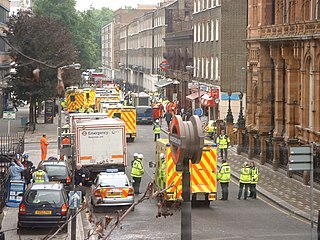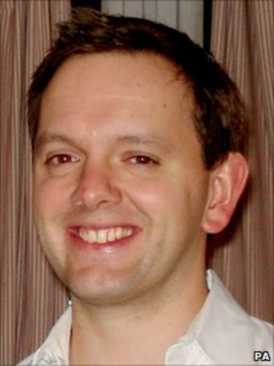Related Research Articles

The Specialist Firearms Command is the firearms unit of the Metropolitan Police. The Command is responsible for providing a firearms-response capability, assisting the rest of the service which is not routinely armed.

The 7 July 2005 London bombings, also referred to as 7/7, were a series of four coordinated suicide attacks carried out by Islamist terrorists that targeted commuters travelling on London's public transport during the morning rush hour.

The following is a timeline of the 7 July 2005 London bombings and 21 July 2005 London bombings.
SO10 was the former designation of the Metropolitan Police's Covert Operations Group.
On Thursday, 21 July 2005, four attempted bomb attacks by Islamist extremists disrupted part of London's public transport system as a follow-up attack from the 7 July 2005 London bombings that occurred two weeks earlier. The explosions occurred around midday at Shepherd's Bush, Warren Street and Oval stations on the London Underground, and on London Buses route 26 in Haggerston on Hackney Road. A fifth bomber dumped his device without attempting to set it off.
There are six known secret anti terrorist policies of the Metropolitan Police. They are Operations Clydesdale, Rainbow, Kratos, Trammel, Camion and Lightning. None of them have had the operational details formally disclosed, and as a result, little information is known on these.
In June 2000, the North Caucasian Chechen separatist-led Chechen insurgents added suicide bombing to their tactics in their struggle against Russia. Since then, there have been dozens of suicide attacks within and outside the republic of Chechnya, resulting in thousands of casualties among Russian security personnel and civilians. The profiles of the suicide bombers have varied, as have the circumstances surrounding the bombings.
The open verdict is an option open to a coroner's jury at an inquest in the legal system of England and Wales. The verdict means the jury confirms the death is suspicious, but is unable to reach any other verdicts open to them. Mortality studies consider it likely that the majority of open verdicts are recorded in cases of suicide where the intent of the deceased could not be proved, although the verdict is recorded in many other circumstances.
Diarmuid O'Neill, was a volunteer in the Provisional Irish Republican Army (IRA). O'Neill was killed in London in 1996 during a police raid on the hotel where he and two other IRA volunteers were staying. Due to the circumstances surrounding the killing, Amnesty International has called for a review of the police investigation into the killing of O'Neill. O'Neill was the only IRA member to be killed by police in Great Britain.
In the United Kingdom police firearm policy varies by constituent countries. In Northern Ireland, all police officers carry firearms whereas in the rest of the United Kingdom, firearms are carried only by specially-trained firearms officers. The arming of police in Great Britain is a much debated topic.

Shoot on Sight is a 2007 British film directed by Jag Mundhra and produced by Aron Govil. The film was marketed and distributed globally by Aron Govil Productions Inc. The cast includes Brian Cox, Sadie Frost, Naseeruddin Shah and Om Puri.

Jean Charles da Silva e de Menezes was a Brazilian man killed by officers of the London Metropolitan Police Service at Stockwell station on the London Underground, after he was wrongly deemed to be one of the fugitives involved in the previous day's failed bombing attempts. These events took place two weeks after the London bombings of 7 July 2005, in which 52 people were killed.

The Terrorist Hunters is a controversial non-fiction book by former senior police officer Andy Hayman, co-written by Margaret Gilmore, about Hayman's role as head of the Metropolitan Police's Specialist Operations Division. The Attorney General for England and Wales, Baroness Scotland QC, sought, and initially won, a High Court injunction against the publication of the book. The book was reported to have sold 2,500 pre-order copies before the injunction was issued.
The DHKP/C insurgency in Turkey refers to the Marxist–Leninist insurgency waged by the Revolutionary People's Liberation Party/Front (DHKP/C) against the Republic of Turkey, ongoing since 1990. The insurgency began with political assassinations in the early 1990s, and has escalated in the past few years with the use of suicide bombers.

The 2015 police raids in Turkey were a series of police raids conducted by the General Directorate of Security in 16 different Provinces of Turkey. The July 20th, 2015 Suruç bombing in Suruç killed 32 Kurds. Claimed by ISIS, it was perceived by Kurdish militants as a collaboration between ISIS and Turkey security services, leading to a series of revenge attacks on Turkish policemen and military positions in Adıyaman and Ceylanpınar. The Ceylanpınar incidents saw the assassination of 2 policemen by operatives of disputed affiliation, attributed to the Kurdistan Workers' Party (PKK), and became the Casus belli for Turkey operations in both Turkey and Iraq.

A police raid became a shootout between at least one hundred French police and soldiers and suspected members of the Islamic State of Iraq and the Levant in the Paris suburb of Saint-Denis.
The 2020 Jolo bombings occurred on August 24, 2020, when insurgents alleged to be jihadists from the Abu Sayyaf group detonated two bombs in Jolo, Sulu, Philippines, killing 14 people and wounding 75 others. The first occurred as Philippine Army personnel were assisting in carrying out COVID-19 humanitarian efforts. The second, a suicide bombing, was carried out near the Our Lady of Mount Carmel Cathedral.

Mark Saunders was a British barrister who was shot dead by police on 6 May 2008 after a five-hour siege at his home in Markham Square in Chelsea, London. Saunders was a successful divorce lawyer who struggled with depression and alcoholism. He had been behaving erratically and drinking heavily in the hours before the incident. Neighbours called the police after Saunders repeatedly fired a shotgun from a window shortly before 17:00. When armed police officers arrived, Saunders fired at their vehicle and the siege began. More armed officers arrived and took up positions in surrounding buildings and on the street. Saunders fired on two more occasions and the police returned fire, slightly wounding him. Around 20 minutes after the previous round of shooting, just after 21:30, Saunders waved the shotgun out of a window. As he lowered it in the direction of a group of police officers, seven officers fired eleven shots, of which at least five struck him. Police entered his flat minutes later and Saunders was taken to a waiting ambulance where he was pronounced dead.
References
- 1 2 Burns, Jimmy (25 July 2005). "Met adopted secret shoot-to-kill policy in the face of a new and deadly threat". Financial Times. Archived from the original on 10 September 2005.
- 1 2 3 4 5 6 Swain, Steve (27 October 2005). Suicide Terrorism. Metropolitan Police Authority (Report). Archived from the original on 16 July 2011. Retrieved 18 December 2015– via Wayback Machine.
- ↑ Taylor, Peter (8 March 2006). "The terrorist who wasn't". The Guardian.
- 1 2 3 4 Stockwell One: Investigation into the shooting of Jean Charles de Menezes at Stockwell underground station on 22 July 2005 (PDF) (Report). Independent Police Complaints Commission. 8 November 2007. Archived from the original (PDF) on 8 September 2010.
- 1 2 Harrison, David; Johnston, Chris (24 July 2005). "Muslims back 'shoot to kill' despite an innocent man's death". The Daily Telegraph.
- ↑ Steele, John (16 November 2005). "Police used 'dum dum' bullets to kill de Menezes". The Telegraph.
- ↑ "Brian Paddick's evidence to de Menezes inquest" (PDF). 5 November 2008. Archived from the original (PDF) on 17 March 2009.
- ↑ Nelson, Fraser; Chamberlain, Gethin; Kirkup, James (15 July 2005). "Police may receive shoot-to-kill orders". The Scotsman.
- ↑ "Will police now shoot to kill?". BBC News. 22 July 2005. Retrieved 9 December 2009.
- ↑ Ansari, Fahad (June 2006). British Anti-Terrorism: A Modern Day Witch-hunt (PDF) (Report). Islamic Human Rights Commission.
- ↑ Husain, Miranda (29 July 2005). "VIEW: Metropolitan Police — licensed to kill". Pakistan Daily Times.
- ↑ "Police censured over Menezes case". BBC News. 8 November 2007.
- ↑ Henry, Emma (1 November 2007). "De Menezes: Met guilty over health and safety". The Telegraph.
- ↑ Laville, Sandra; Siddique, Haroon (12 December 2008). "Jean Charles de Menezes inquest records open verdict". The Guardian.
- ↑ Steele, John (8 March 2006). "Shoot-to-kill tactic still viable, say police chiefs". The Telegraph.
- ↑ Williams, Rachel (12 December 2008). "De Menezes: How the Met tried to win the PR war". The Guardian.
- ↑ Wilson, Jeremy (2 April 2009). MPS response to the MPA Stockwell scrutiny (Report). Metropolitan Police Authority. Archived from the original on 16 July 2011.
- ↑ Stewart, Moir (20 February 2009). Inquest into the death of Jean Charles de Menezes - Metropolitan Police Commissioner's response to the Rule 43 Report (PDF) (Report). Metropolitan Police Service. Archived from the original (PDF) on 16 July 2011.
- ↑ Gardner, Frank (26 September 2013). "Nairobi attack: Could it happen in Britain?". BBC News.